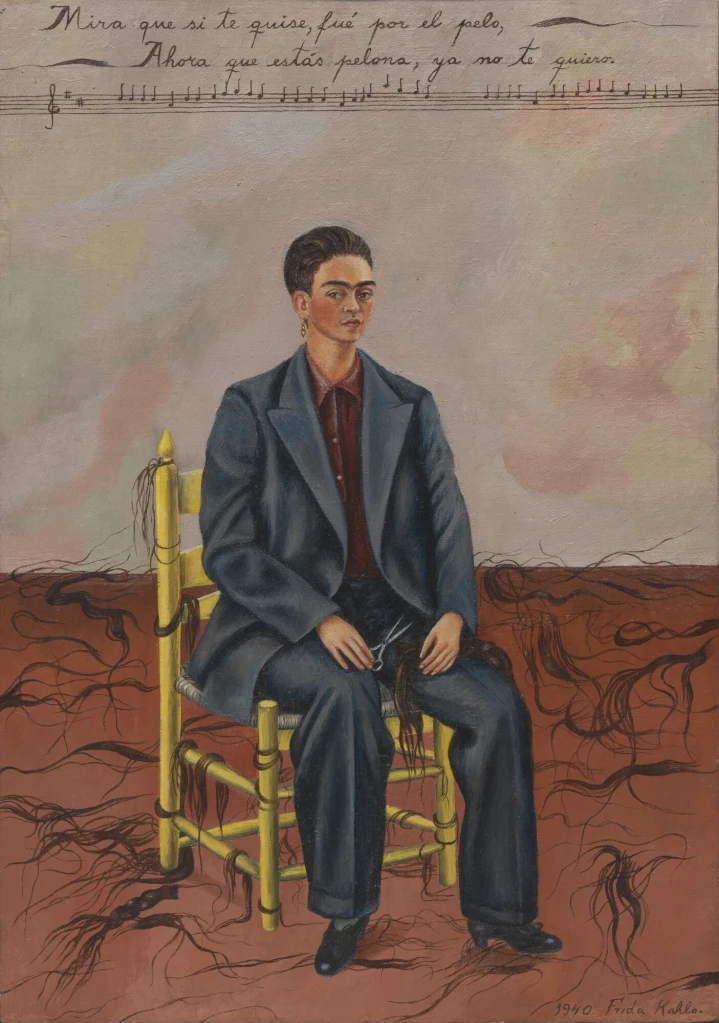Magdalena Carmen Frida Kahlo y Calderón known in the art world as just Frida Kahlo was a Mexican painter whose work primarily focuses on themes of identity, death, and personal life experience. Kahlo’s Self-Portrait with Cropped Hair and double self portrait The Two Fridas capture her struggle with identity. Kahlo’s colorful self-portraits and surrealist paintings challenged the gender and identity norms of the Western world.

Kahlo disagreed with the Western concepts of gender from an early age. Directly challenging gender norms, Self-Portrait with Cropped Hair (1940) shows the artist in a men’s suit with a traditionally male haircut. She is seated in a chair in the center of the frame making eye contact with the viewer. She is holding scissors in one hand and a lock of hair in the other and it appears that she has just cut her own hair. There are locks of hair scattered throughout the foreground and middle ground of the painting. At the time of this painting, women traditionally presented with long hair and wearing a dress or skirt. In Mexico a women’s long hair was a sign of beauty and womanhood.
She exhibits herself in this painting from an androgynous angle sporting mens attier and a short hair cut. By cutting her hair, Kahlo stripps herself of the idealistic portrayal of what a woman should look like. Due to the artist’s medical issues and injuries, Kahlo was unable to bear children and suffered multiple miscarriages. Carrying a child and raising a family was something that was expected of women at that time while the men worked to support the family financially. This burdened Kahlo and created personal conflict with her identity as a woman. This painting was created following the artist’s divorce to her husband in 1939. During this time Kahlo swore she would sell her art inorder to be financially independent from any man. Therefore, this painting where she appears more masculine can also represent her becoming her own husband, and show that women do not need to rely on a man to be independent. This painting broke boundaries of both feminine beauty and expectations.

Not only did Kahlo document her ambiguity and experimentation with her identity as a woman, she also expressed her mixed heritage. In her painting The Two Fridas (1939) the artist depicts two sides of herself. On the left is Kahlo in a white European style dress in connection to her German heritage from her fathers side. And on the right she is depicted wearing a traditional Mexican skirt and blouse to represent her Mexican and Spanish heritage from her mothers side. The two figures are seated on a bench holding hands against a dark cloudy background. Their hearts are exposed and appear to be connected by a vein.
Kahlo moved to the United States in 1930 during the time of the Great Depression. This was an uncertain time for immigrants coming from Mexico and discrimination against spanish-speaking individuals grew as unemployment rates rose. This painting shows how the artist’s two very different sides are connected. Kahlo was proud of her Mexican and Spanish heritage and she symbolizes this in the attire worn by her on the right. She shows that although she had immigrated from Mexico, She would not cut herself off from her Mexican heritage. America was thought to have been a “melting pot” where inorder to avoid discrimination a person had to abandon their culture to fit into the societal norms of the U.S. This painting fights this idea that a person had to fully conform to the identity of their location.
The work of Frida Kahlo fights both gender constructs and the discrimination faced by immigrants. Her work stems from Kahlo’s own personal experiences and reality as a woman of both European and Mexican descent. Her work continues to be an inspiration by challenging the gender and identity norms of the Western world.
Sources
Bakewell, Liza. “Frida Kahlo: A Contemporary Feminist Reading.” Frontiers: A Journal of Women Studies 13, no. 3 (1993): 165–89. https://doi.org/10.2307/3346753.
Blakemore, Erin. “The Brutal History of Anti-Latino Discrimination in America.” Google. Google, August 29, 2018. https://www.google.com/amp/s/www.history.com/.amp/news/the-brutal-history-of-anti-lat ino-discrimination-in-america.
The Museum of Modern Art. 2021. Frida Kahlo. Self-Portrait with Cropped Hair. 1940 | MoMA. [online] Available at: https://www.moma.org/collection/works/78333?artist_id=2963&page=1&sov_referrer=artist.